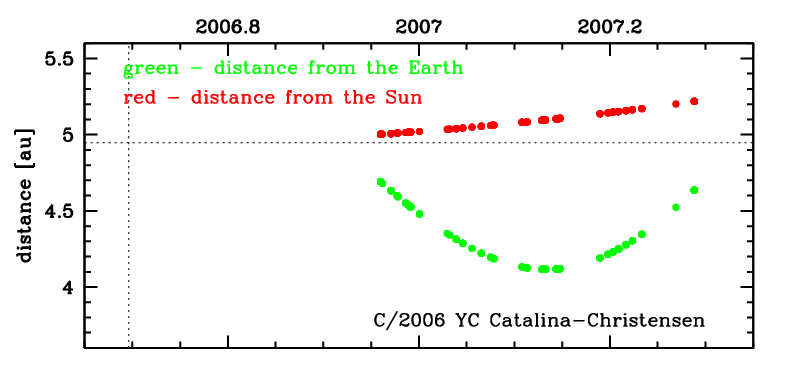C/2006 YC Catalina
more info
C/2006 YC was discovered almost simultaneously on 16 December 2006 by the Catalina Sky Survey as an apparently asteroidal object, and by Eric J. Christensen during the course of Mount Lemmon Survey who quickly reported its cometary appearance.
This comet made its closest approach to the Earth on 17 February 2007 (4.116 au), two months after its discovery and five months after perihelion passage.
Solution given here is based on data spanning over 0.3 yr in a narrow range of heliocentric distances from 5.00 au to 5.22 au.
This Oort spike comet suffers moderate planetary perturbations during its passage through the planetary system that lead to a notable more tight future orbit (see future barycentric orbit).
See also Królikowska 2014 and Królikowska and Dybczyński 2017.
This comet made its closest approach to the Earth on 17 February 2007 (4.116 au), two months after its discovery and five months after perihelion passage.
Solution given here is based on data spanning over 0.3 yr in a narrow range of heliocentric distances from 5.00 au to 5.22 au.
This Oort spike comet suffers moderate planetary perturbations during its passage through the planetary system that lead to a notable more tight future orbit (see future barycentric orbit).
See also Królikowska 2014 and Królikowska and Dybczyński 2017.
| solution description | ||
|---|---|---|
| number of observations | 147 | |
| data interval | 2006 12 16 – 2007 04 15 | |
| data type | observed only after perihelion (POST) | |
| data arc selection | entire data set (STD) | |
| range of heliocentric distances | 5 au – 5.22au | |
| detectability of NG effects in the comet's motion | NG effects not determinable | |
| type of model of motion | GR - gravitational orbit | |
| data weighting | YES | |
| number of residuals | 286 | |
| RMS [arcseconds] | 0.42 | |
| orbit quality class | 2a | |
| next orbit statistics, both Galactic and stellar perturbations were taken into account | ||
|---|---|---|
| no. of returning VCs in the swarm | 5001 | * |
| no. of escaping VCs in the swarm | 0 | |
| no. of hyperbolas among escaping VCs in the swarm | 0 | |
| next reciprocal semi-major axis [10-6 au-1] | 421.90 – 436.82 – 452.44 | |
| next perihelion distance [au] | 4.94354 – 4.94371 – 4.94386 | |
| next aphelion distance [103 au] | 4.42 – 4.57 – 4.74 | |
| time interval to next perihelion [Myr] | 0.104 – 0.109 – 0.115 | |
| percentage of VCs with qnext < 10 | 100 | |
| next_g orbit statistics, here only the Galactic tide has been included | ||
|---|---|---|
| no. of returning VCs in the swarm | 5001 | * |
| no. of escaping VCs in the swarm | 0 | |
| no. of hyperbolas among escaping VCs in the swarm | 0 | |
| next reciprocal semi-major axis [10-6 au-1] | 421.91 – 436.82 – 452.44 | |
| next perihelion distance [au] | 4.94064 – 4.94074 – 4.94084 | |
| next aphelion distance [103 au] | 4.42 – 4.57 – 4.74 | |
| time interval to next perihelion [Myr] | 0.104 – 0.109 – 0.115 | |
| percentage of VCs with qnext < 10 | 100 | |
